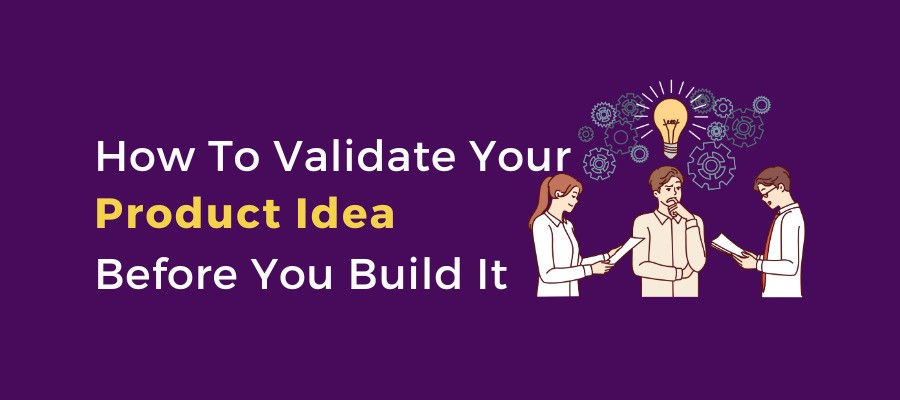How To Validate Your Product Idea Before You Build It

Do you have a product idea buzzing in your head? That's exciting, but validating your idea is crucial before you dive into the deep end and start building. This step is often overlooked but can set you up for success or save you from potential failure. But Why Validate?
Imagine pouring time, money, and energy into developing a product only to discover that no one needs or wants it. That’s a scenario you can avoid with proper validation. Validation helps you gauge if there's a market for your idea and provides insights on refining your product before it hits the market. Essentially, validation acts as a reality check.
Let’s walk through the steps to validate your product idea, ensuring that you build something that resonates with your target audience when you create.
Understand The Problem You’re Solving
Before anything else, ask yourself: What problem does your product solve? If you’re unsure, that’s a red flag. Successful products solve real, tangible issues. Spend time identifying the customer's pain points and looking for feasible solutions.
Pro Tip: Engage with your audience directly. Whether it’s through surveys, interviews, or social media polls, ask them about their challenges and frustrations. It will give you a clearer picture of whether your product idea addresses a real need.
Identify Your Target Audience
Who are you building this product for? Knowing your audience is critical. Are they millennials, tech-savvy individuals, or perhaps small business owners? It’s indeed better to be more specific.
Now that you know the problem and your audience, it’s time to dig deeper. Is there a market for your product? A good starting point is to look at what’s already out there. Are there existing products solving the same problem? If yes, how well are they doing?
Conduct Market Research
Take a close look at your competitors. What are their strengths and weaknesses? What gaps can your product fill? This step not only helps you understand the market but also allows you to position your product uniquely.
Tools to Use:
- Google Trends: Check how often people search for solutions related to your idea.
- Ahrefs or SEMrush: Analyze keywords and understand what potential customers are looking for.
Create a Minimum Viable Product (MVP)
Consider the MVP your product's most basic version. It’s for attracting early customers and bringing more product value. It’s a powerful tool for validation because it allows you to test your idea with real users without investing heavily in a fully developed product.
Benefits of an MVP:
- Quick Feedback: Get real-world insights on what works and what doesn’t.
- Cost-Efficient: Build just enough to test your concept without breaking the bank.
- Iterate Faster: Based on feedback, you can quickly make improvements.
Test the Market with Pre-Sales
If people will pay for your product before it’s built, you’ve got validation gold. Pre-sales can be done through various channels, such as landing pages, crowdfunding campaigns, or even directly reaching potential customers.
Crowdfunding: Platforms like Kickstarter or Indiegogo can help you validate your idea and raise funds simultaneously. Plus, you get direct feedback from your backers.
Landing Page: Create a simple landing page that explains your product idea and includes a call-to-action (CTA) for pre-orders or sign-ups. Drive traffic to this page and analyze the results. High conversion rates? Your idea might just be a winner!
Engage with Your Community
Building a community around your product idea is another excellent way to validate it. Social media is your friend here. Share your idea with your followers, engage in relevant online forums, or create a dedicated group. The key is to listen—what are people saying? Are they excited? Do they have suggestions for improvement?
Feedback Loop: Use platforms like Twitter, Instagram, or Facebook to gauge interest. Run polls to ask open-ended questions and get direct feedback.
Pilot Testing with a Small Group
Before going full-scale, consider a small pilot test. Select a group of users who closely match your target audience and let them use your MVP. Their feedback will be instrumental in refining your product.
Incentivize Participation: Offer incentives like discounts or exclusive access in exchange for their honest feedback. This approach not only validates your idea but also builds early brand loyalty.
Analyze the Data and Iterate
Data is your best friend at every step. Whether it’s analytics from your landing page, feedback from your community, or insights from your MVP users, dig into the data. What’s working? What’s not?
Iterate Quickly: Don’t be afraid to pivot based on what the data tells you. Sometimes, validation reveals that your original idea needs tweaking or, in some cases, a complete overhaul. That’s okay—it’s better to learn this now than after a full-scale launch.
Final Thoughts!
Validation isn’t just a step in product development; it’s a mindset. It’s about staying curious and willing to adapt. When you validate your product idea, you’re not just confirming its viability—you’re setting yourself up for success in a competitive market. So, before you build, take the time to validate. Your future self will thank you!
Reference:
https://www.shopify.com/blog/validate-product-ideas



